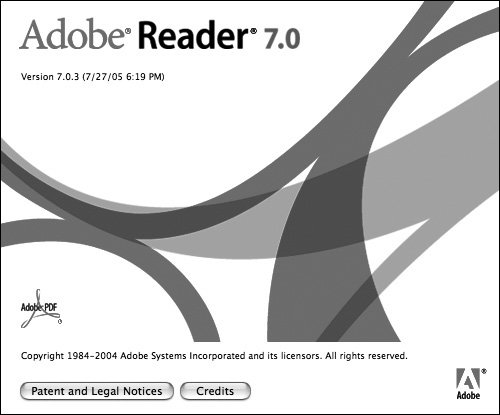About PDF and Acrobat
| It's very common for users of the free Adobe Reader software to think that they have a copy of the Adobe Acrobat application. Acrobat is actually a family of software applications for creating, editing, and otherwise manipulating PDF files. PDF stores a document's information and content including its raster images, vector objects, and text in a compact, platform-, application-, and usually, font-independent form. (Font-independent means that you don't have to own a copy of the font that was used to create the document; it's included in the PDF file. For comparison, think of receiving a Word document that was created using a font you don't have….) Here we discuss some basic concepts for working with PDF files, including distinctions among the various applications in the Acrobat family. The Acrobat FamilyThe family of Adobe Acrobat software consists of four primary applications:
Figure 14-1. The Adobe Reader 7.0 application, used for viewing, navigating, and printing PDF files, can be downloaded free from the Adobe web site. Adobe has also developed some additional members of the Acrobat family such as Acrobat Elements and Adobe LifeCycle server products for specialized markets. For more information, go to http://www.adobe.com/products/acrobat/main.html. PDF VersionsPDF is not a static format. PDF and its specification have continued to evolve with each new Acrobat release to reflect new features. When you're creating a PDF file, it's important to save it with the correct compatibility for the features you want to include, and for how the file will be used (its destination). For more information, including a table comparing PDF versions, see "Setting Appropriate Compatibility" later in this chapter. One File Doesn't Fit AllUsing Acrobat 7.0 Professional, you can create PDF files in a range of file sizes and with added elements. What's important to keep in mind is that one size does not fit all uses. PDF files can range from fat to thin and everywhere in between, because they can be created and used for myriad purposes: PDF files created for print can get huge if they contain high-resolution images, with fonts fully embedded. Others, for online viewing and quick downloading from the Internet or an intranet, are made as small as possible. Still others, appropriate for an eBook (electronic book) or printing on a desktop printer, can be medium-sized.
In addition, extra elements can be added to a PDF document for example, bookmarks, links, or digital media to provide interactivity; comments as part of a review cycle; or security for a highly sensitive project. At other times, these extra elements need to be stripped out, such as when the file must be sent off to the printer. If you want to use a PDF file for other than its original purpose, you may need to create a new version or repurpose an old one. For example, printing a small, low-resolution PDF file from the web may produce pixelated, low-resolution images and font substitutions. On the other hand, posting a multi-megabyte monster PDF file intended for print on your web site will only frustrate viewers, and they'll probably choose not to look at it at all. (We discuss how to repurpose a file with the PDF Optimizer tool in "Acrobat 7.0 Professional Features.") |
EAN: 2147483647
Pages: 192